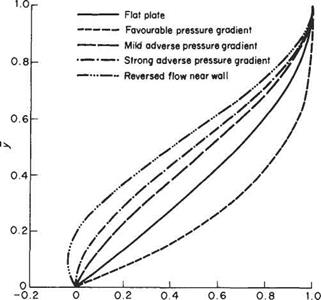Effects of an external pressure gradient
In the previous section, it was noted that in most practical aerodynamic applications the mainstream velocity and pressure change in the streamwise direction. This has a profound effect on the development of the boundary layer. It can be seen from Fig. 7.2 that the net streamwise force acting on a small fluid element within the boundary layer is
дт dp 9Ї6у-9-Хвх
When the pressure decreases (and, correspondingly, the velocity along the edge of the boundary layer increases) with passage along the surface the external pressure
|
Fig. 7.6 Effect of external pressure gradient on the velocity profile in the boundary layer |
gradient is said to be favourable. This is because dpjdx < 0 so, noting that drjdy < 0, it can be seen that the streamwise pressure forces help to counter the effects, discussed earlier, of the shearing action and shear stress at the wall. Consequently, the flow is not decelerated so markedly at the wall, leading to a fuller velocity profile (see Fig. 7.6), and the boundary layer grows more slowly along the surface than for a flat plate.
The converse case is when the pressure increases and mainstream velocity decreases along the surface. The external pressure gradient is now said to be unfavourable or adverse. This is because the pressure forces now reinforce the effects of the shearing action and shear stress at the wall. Consequently, the flow decelerates more markedly near the wall and the boundary layer grows more rapidly than in the case of the flat plate. Under these circumstances the velocity profile is much less full than for a flat plate and develops a point of inflexion (see Fig. 7.6). In fact, as indicated in Fig. 7.6, if the adverse pressure gradient is sufficiently strong or prolonged, the flow near the wall is so greatly decelerated that it begins to reverse direction. Flow reversal indicates that the boundary layer has separated from the surface. Boundary-layer separation can have profound consequences for the whole flow field and is discussed in more detail in Section 7.4.












